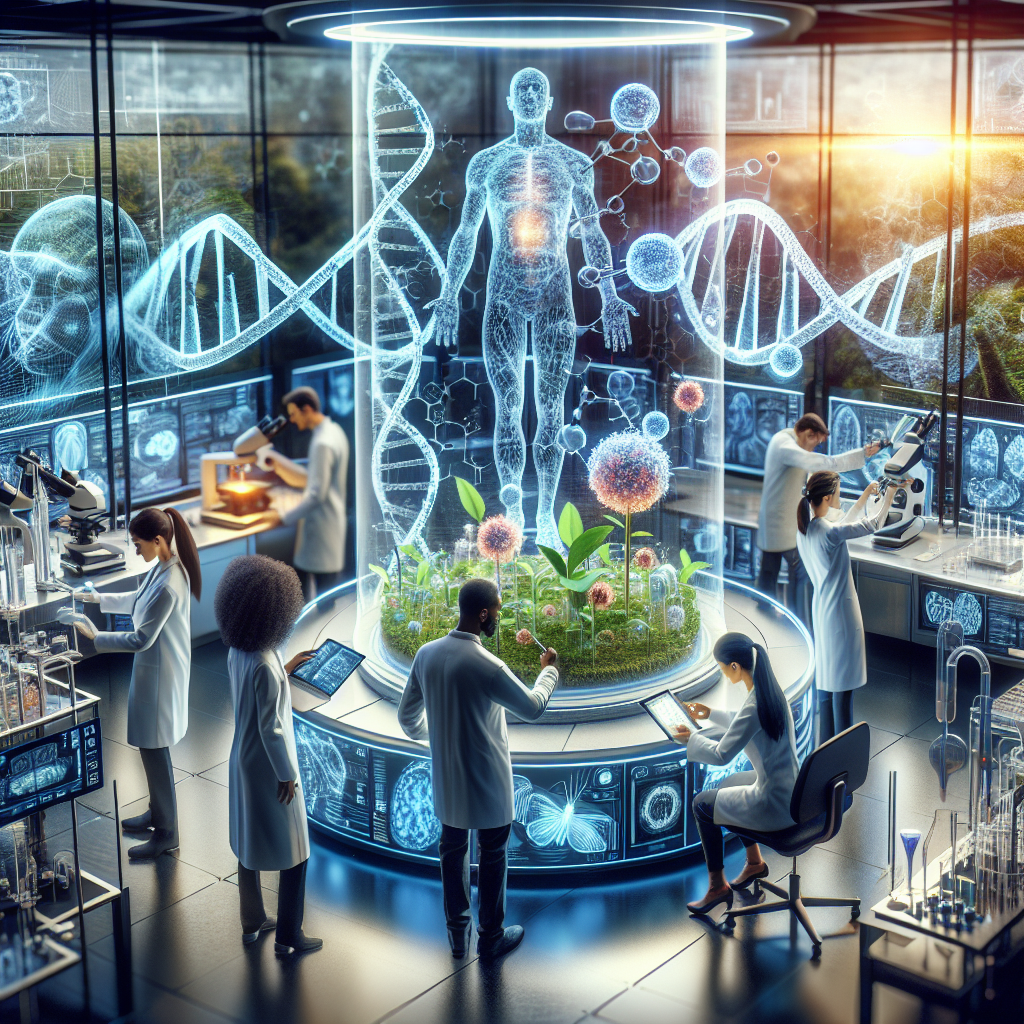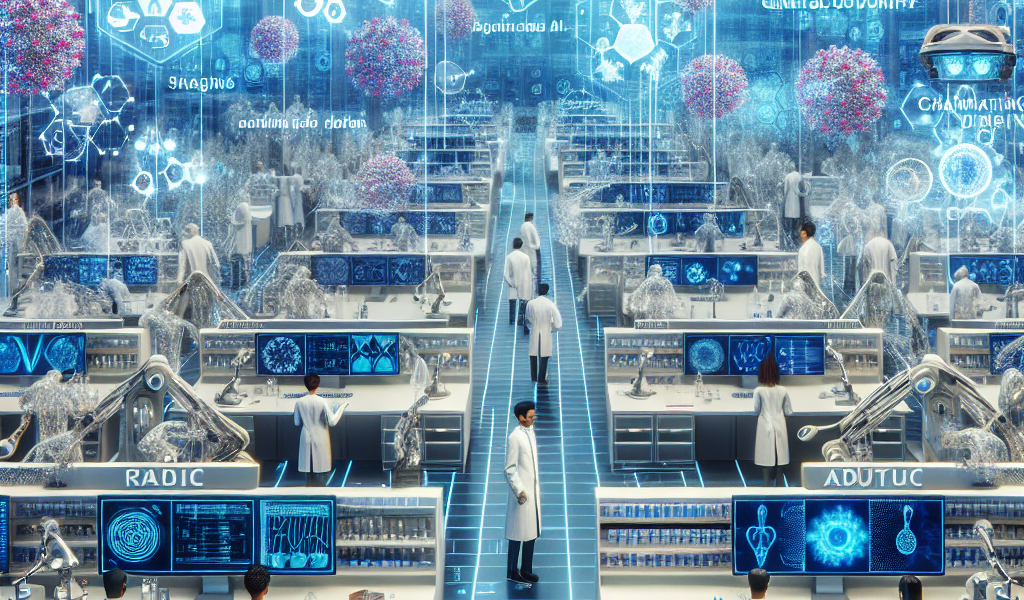-
Table of Contents
“Revolutionizing Health: Pioneering Tomorrow’s Medical Breakthroughs Today”
Introduction

The future of biotechnology holds immense promise, particularly in the realm of medicine, where groundbreaking innovations are poised to revolutionize healthcare. Advances in genetic engineering, personalized medicine, and regenerative therapies are at the forefront of this transformation, offering unprecedented opportunities to treat and potentially cure a wide array of diseases. With the advent of CRISPR technology, scientists can now edit genes with remarkable precision, paving the way for targeted treatments that address the root causes of genetic disorders. Additionally, the integration of artificial intelligence and big data analytics in biotechnology is enabling the development of highly personalized medical treatments, tailored to the unique genetic makeup of individual patients. Regenerative medicine, including stem cell therapy and tissue engineering, is also making significant strides, promising to repair or replace damaged tissues and organs. As these innovations continue to evolve, the future of biotechnology in medicine holds the potential to not only enhance the quality of life but also extend it, ushering in a new era of healthcare.
Gene Editing: Revolutionizing Disease Treatment
Gene editing, a groundbreaking advancement in biotechnology, is poised to revolutionize the treatment of diseases, offering unprecedented possibilities for medical science. At the forefront of this revolution is CRISPR-Cas9, a powerful tool that allows scientists to make precise modifications to DNA. This technology has the potential to correct genetic defects, eradicate diseases, and even enhance human capabilities, marking a significant leap forward in the field of medicine.
The promise of gene editing lies in its ability to target and modify specific genes within an organism’s genome. This precision is crucial for treating genetic disorders, which are often caused by mutations in a single gene. For instance, sickle cell anemia, a debilitating condition caused by a mutation in the hemoglobin gene, could potentially be cured by editing the faulty gene in a patient’s stem cells. Early clinical trials have shown promising results, with patients experiencing significant improvements in their symptoms.
Moreover, gene editing holds the potential to combat infectious diseases. By altering the genes of mosquitoes, scientists aim to reduce the spread of malaria, a disease that claims hundreds of thousands of lives each year. Similarly, gene editing could be used to develop more effective treatments for viral infections such as HIV. By targeting the virus’s genetic material, researchers hope to eliminate the infection at its source, offering a potential cure for millions of people worldwide.
In addition to treating existing conditions, gene editing opens the door to preventive medicine. By identifying and correcting genetic predispositions to diseases such as cancer, heart disease, and diabetes, it may be possible to prevent these conditions from developing in the first place. This proactive approach could transform healthcare, shifting the focus from treatment to prevention and significantly reducing the burden of chronic diseases on individuals and healthcare systems.
However, the rapid advancement of gene editing technology also raises ethical and safety concerns. The potential for off-target effects, where unintended changes are made to the genome, poses a significant risk. These unintended modifications could lead to unforeseen health issues, making it imperative to ensure the accuracy and safety of gene editing techniques. Rigorous testing and regulatory oversight are essential to mitigate these risks and ensure that gene editing is used responsibly.
Ethical considerations also come into play when discussing the potential for human enhancement. The ability to edit genes could lead to the creation of so-called “designer babies,” where parents select specific traits for their children. This possibility raises questions about the societal implications of such practices, including issues of equity and access. It is crucial to establish ethical guidelines and policies to navigate these complex issues and ensure that gene editing is used for the greater good.
Despite these challenges, the potential benefits of gene editing in medicine are immense. Continued research and development in this field could lead to breakthroughs that were once thought to be the stuff of science fiction. As we stand on the brink of a new era in biotechnology, it is essential to balance innovation with caution, ensuring that the advancements in gene editing are harnessed to improve human health and well-being.
In conclusion, gene editing represents a transformative leap in the treatment and prevention of diseases. With its ability to make precise modifications to the genome, this technology holds the promise of curing genetic disorders, combating infectious diseases, and ushering in a new era of preventive medicine. However, it is imperative to address the ethical and safety concerns associated with gene editing to ensure its responsible use. As we navigate this exciting frontier, the future of biotechnology in medicine looks incredibly promising, offering hope for a healthier and more equitable world.
Personalized Medicine: Tailoring Therapies to Individual Genomes
The future of biotechnology is poised to revolutionize the field of medicine, with personalized medicine at the forefront of this transformation. Personalized medicine, also known as precision medicine, involves tailoring medical treatments to the individual characteristics of each patient, particularly their genetic makeup. This approach stands in stark contrast to the traditional one-size-fits-all model of healthcare, which often fails to account for the genetic diversity among patients. As advancements in genomic technologies continue to accelerate, the potential for personalized medicine to improve patient outcomes becomes increasingly apparent.
One of the most significant innovations driving personalized medicine is the advent of next-generation sequencing (NGS). This technology allows for the rapid and cost-effective sequencing of entire genomes, providing a comprehensive view of an individual’s genetic blueprint. By identifying specific genetic mutations and variations, healthcare providers can develop targeted therapies that are more effective and have fewer side effects. For instance, in oncology, NGS has enabled the identification of genetic mutations that drive cancer progression, leading to the development of targeted therapies such as tyrosine kinase inhibitors for certain types of leukemia and lung cancer.
Moreover, the integration of big data and artificial intelligence (AI) into personalized medicine is further enhancing its potential. AI algorithms can analyze vast amounts of genomic data, identifying patterns and correlations that may not be immediately apparent to human researchers. This capability is particularly valuable in the field of pharmacogenomics, which studies how an individual’s genetic makeup affects their response to drugs. By leveraging AI, researchers can predict which patients are likely to benefit from a particular medication and which may experience adverse reactions, thereby optimizing treatment plans and reducing the trial-and-error approach often associated with drug prescriptions.
In addition to improving treatment efficacy, personalized medicine also holds promise for disease prevention. By understanding an individual’s genetic predisposition to certain conditions, healthcare providers can implement proactive measures to mitigate risk. For example, individuals with a family history of cardiovascular disease can undergo genetic testing to identify specific risk factors, allowing for early intervention through lifestyle modifications and preventive medications. Similarly, genetic screening for hereditary cancers, such as BRCA1 and BRCA2 mutations associated with breast and ovarian cancer, enables at-risk individuals to make informed decisions about their health, including increased surveillance or prophylactic surgeries.
Despite the tremendous potential of personalized medicine, several challenges remain. One of the primary obstacles is the ethical and privacy concerns associated with genetic data. Ensuring that patients’ genetic information is securely stored and used responsibly is paramount to maintaining public trust in these technologies. Additionally, the high cost of genomic testing and targeted therapies can limit accessibility, raising questions about healthcare equity. Addressing these issues will require concerted efforts from policymakers, healthcare providers, and the biotechnology industry to develop frameworks that balance innovation with ethical considerations and affordability.
Furthermore, the successful implementation of personalized medicine necessitates a paradigm shift in medical education and practice. Healthcare professionals must be equipped with the knowledge and skills to interpret genetic data and integrate it into clinical decision-making. This will involve updating medical curricula and providing ongoing training to ensure that practitioners are well-versed in the latest advancements in genomics and bioinformatics.
In conclusion, personalized medicine represents a transformative approach to healthcare, offering the potential to tailor therapies to individual genomes and improve patient outcomes. As genomic technologies, big data, and AI continue to advance, the promise of personalized medicine becomes increasingly attainable. However, addressing the ethical, privacy, and accessibility challenges will be crucial to realizing its full potential and ensuring that the benefits of these innovations are accessible to all.
Bioprinting: The Next Frontier in Organ Transplants
Bioprinting, a revolutionary advancement in the field of biotechnology, is poised to transform the landscape of organ transplants. This cutting-edge technology, which involves the layer-by-layer construction of biological tissues using 3D printing techniques, holds the promise of addressing the critical shortage of donor organs and reducing the risk of transplant rejection. As researchers continue to make strides in this domain, the potential applications of bioprinting in medicine are becoming increasingly apparent.
One of the most significant advantages of bioprinting is its ability to create customized organs tailored to the specific needs of individual patients. By using a patient’s own cells as the building blocks, bioprinting can produce organs that are a perfect genetic match, thereby minimizing the likelihood of immune rejection. This personalized approach not only enhances the success rate of transplants but also reduces the dependency on immunosuppressive drugs, which can have severe side effects.
Moreover, bioprinting offers a solution to the perennial problem of organ shortages. According to the World Health Organization, thousands of patients die each year while waiting for a suitable organ donor. Bioprinting has the potential to alleviate this crisis by providing an alternative source of organs that can be produced on demand. This capability could revolutionize the field of transplantation, making it possible to save countless lives that would otherwise be lost due to the unavailability of donor organs.
In addition to its applications in organ transplants, bioprinting is also being explored for its potential in drug testing and disease modeling. Traditional methods of drug testing often rely on animal models, which may not accurately replicate human physiology. Bioprinted tissues, on the other hand, can provide a more reliable platform for testing the efficacy and safety of new drugs. This approach not only accelerates the drug development process but also reduces the ethical concerns associated with animal testing.
Furthermore, bioprinting can be used to create disease models that mimic the complex interactions within human tissues. These models can be invaluable for studying the progression of diseases and identifying potential therapeutic targets. For instance, researchers are using bioprinted tissues to investigate the mechanisms underlying cancer metastasis and to develop more effective treatments for this devastating disease.
Despite the remarkable progress made in bioprinting, several challenges remain to be addressed before it can be widely adopted in clinical practice. One of the primary obstacles is the need to ensure the long-term viability and functionality of bioprinted organs. While researchers have successfully printed simple tissues such as skin and cartilage, more complex organs like the heart and liver present greater challenges due to their intricate structures and diverse cell types.
Additionally, the regulatory landscape for bioprinted organs is still evolving. Ensuring the safety and efficacy of these novel medical products will require rigorous testing and validation, as well as the development of new regulatory frameworks. Collaboration between scientists, clinicians, and regulatory agencies will be essential to navigate these challenges and bring bioprinted organs to the clinic.
In conclusion, bioprinting represents a promising frontier in the field of organ transplants, with the potential to revolutionize medicine by providing customized, on-demand organs and advancing drug testing and disease modeling. While significant hurdles remain, the continued progress in this area holds the promise of transforming healthcare and improving the lives of countless patients. As research and technology advance, the dream of bioprinted organs becoming a reality moves ever closer to fruition.
CRISPR Technology: Ethical Implications and Potential Benefits
CRISPR Technology: Ethical Implications and Potential Benefits
The advent of CRISPR technology has revolutionized the field of biotechnology, offering unprecedented possibilities for medical advancements. CRISPR, an acronym for Clustered Regularly Interspaced Short Palindromic Repeats, allows scientists to edit genes with remarkable precision. This breakthrough has the potential to eradicate genetic disorders, enhance disease resistance, and even extend human lifespan. However, as with any powerful tool, CRISPR raises significant ethical questions that must be addressed to ensure responsible use.
One of the most promising applications of CRISPR technology lies in its ability to treat genetic disorders. Diseases such as cystic fibrosis, sickle cell anemia, and muscular dystrophy, which are caused by specific genetic mutations, could potentially be corrected at the DNA level. By targeting and editing the faulty genes, CRISPR offers a potential cure rather than merely managing symptoms. This represents a paradigm shift in medicine, moving from treatment to prevention and cure. Moreover, CRISPR could be used to enhance the immune system’s ability to fight off infections and cancers, providing a new line of defense against some of the most challenging diseases.
Despite these promising benefits, the ethical implications of CRISPR technology cannot be overlooked. One of the primary concerns is the potential for unintended consequences. Editing genes in humans could have unforeseen effects, not only on the individual but also on future generations. The possibility of off-target effects, where CRISPR inadvertently alters other parts of the genome, raises questions about the long-term safety and efficacy of this technology. Furthermore, the prospect of germline editing, which involves making changes that can be inherited by offspring, adds another layer of complexity to the ethical debate.
Another significant ethical issue is the potential for CRISPR to exacerbate social inequalities. Access to cutting-edge medical treatments is often limited by socioeconomic factors, and CRISPR is no exception. If only the wealthy can afford gene-editing therapies, this could lead to a new form of genetic inequality, where the rich have access to enhanced health and abilities while the poor are left behind. This raises questions about justice and fairness in the distribution of medical advancements.
Moreover, the potential for CRISPR to be used for non-therapeutic enhancements, such as increasing intelligence or physical abilities, brings up concerns about the definition of normalcy and the potential for a new form of eugenics. The line between therapeutic and enhancement applications is often blurred, making it challenging to establish clear ethical guidelines. The possibility of creating so-called “designer babies” has sparked a global debate about the moral implications of altering human genetics for non-medical reasons.
In light of these ethical concerns, it is crucial to establish robust regulatory frameworks to govern the use of CRISPR technology. International cooperation and dialogue are essential to develop guidelines that ensure the responsible use of gene-editing technologies while maximizing their potential benefits. Public engagement and education are also vital to foster informed discussions about the ethical implications of CRISPR and to build a consensus on acceptable uses of this powerful tool.
In conclusion, CRISPR technology holds immense promise for revolutionizing medicine and improving human health. However, the ethical implications of gene editing must be carefully considered to ensure that the benefits are realized without compromising safety, equity, and moral integrity. As we stand on the brink of a new era in biotechnology, it is imperative to navigate these challenges thoughtfully and responsibly.
Conclusion
The future of biotechnology in medicine is poised for transformative advancements, driven by innovations such as gene editing, personalized medicine, and regenerative therapies. These technologies promise to revolutionize disease treatment and prevention, enhance the precision of medical interventions, and improve patient outcomes. As research progresses and ethical considerations are addressed, biotechnology will likely play a pivotal role in shaping a more effective and personalized healthcare landscape.





